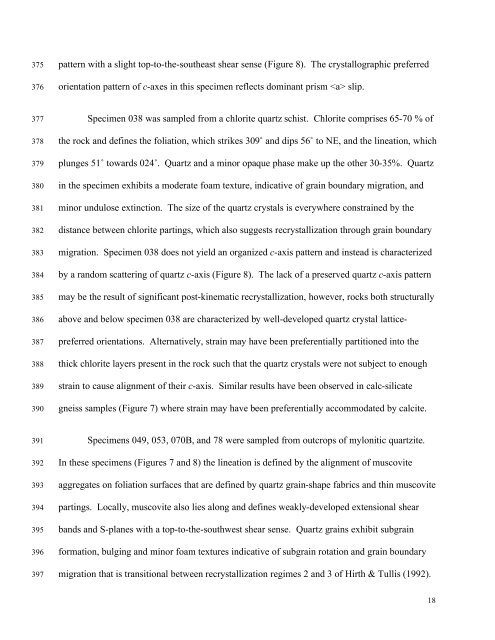Kinematics of the Greater Himalayan sequence, Dhaulagiri Himal ...
Kinematics of the Greater Himalayan sequence, Dhaulagiri Himal ...
Kinematics of the Greater Himalayan sequence, Dhaulagiri Himal ...
You also want an ePaper? Increase the reach of your titles
YUMPU automatically turns print PDFs into web optimized ePapers that Google loves.
375<br />
376<br />
pattern with a slight top-to-<strong>the</strong>-sou<strong>the</strong>ast shear sense (Figure 8). The crystallographic preferred<br />
orientation pattern <strong>of</strong> c-axes in this specimen reflects dominant prism slip.<br />
377<br />
378<br />
379<br />
380<br />
381<br />
382<br />
383<br />
384<br />
385<br />
386<br />
387<br />
388<br />
389<br />
390<br />
Specimen 038 was sampled from a chlorite quartz schist. Chlorite comprises 65-70 % <strong>of</strong><br />
<strong>the</strong> rock and defines <strong>the</strong> foliation, which strikes 309˚ and dips 56˚ to NE, and <strong>the</strong> lineation, which<br />
plunges 51˚ towards 024˚. Quartz and a minor opaque phase make up <strong>the</strong> o<strong>the</strong>r 30-35%. Quartz<br />
in <strong>the</strong> specimen exhibits a moderate foam texture, indicative <strong>of</strong> grain boundary migration, and<br />
minor undulose extinction. The size <strong>of</strong> <strong>the</strong> quartz crystals is everywhere constrained by <strong>the</strong><br />
distance between chlorite partings, which also suggests recrystallization through grain boundary<br />
migration. Specimen 038 does not yield an organized c-axis pattern and instead is characterized<br />
by a random scattering <strong>of</strong> quartz c-axis (Figure 8). The lack <strong>of</strong> a preserved quartz c-axis pattern<br />
may be <strong>the</strong> result <strong>of</strong> significant post-kinematic recrystallization, however, rocks both structurally<br />
above and below specimen 038 are characterized by well-developed quartz crystal latticepreferred<br />
orientations. Alternatively, strain may have been preferentially partitioned into <strong>the</strong><br />
thick chlorite layers present in <strong>the</strong> rock such that <strong>the</strong> quartz crystals were not subject to enough<br />
strain to cause alignment <strong>of</strong> <strong>the</strong>ir c-axis. Similar results have been observed in calc-silicate<br />
gneiss samples (Figure 7) where strain may have been preferentially accommodated by calcite.<br />
391<br />
392<br />
393<br />
394<br />
395<br />
396<br />
397<br />
Specimens 049, 053, 070B, and 78 were sampled from outcrops <strong>of</strong> mylonitic quartzite.<br />
In <strong>the</strong>se specimens (Figures 7 and 8) <strong>the</strong> lineation is defined by <strong>the</strong> alignment <strong>of</strong> muscovite<br />
aggregates on foliation surfaces that are defined by quartz grain-shape fabrics and thin muscovite<br />
partings. Locally, muscovite also lies along and defines weakly-developed extensional shear<br />
bands and S-planes with a top-to-<strong>the</strong>-southwest shear sense. Quartz grains exhibit subgrain<br />
formation, bulging and minor foam textures indicative <strong>of</strong> subgrain rotation and grain boundary<br />
migration that is transitional between recrystallization regimes 2 and 3 <strong>of</strong> Hirth & Tullis (1992).<br />
18

















